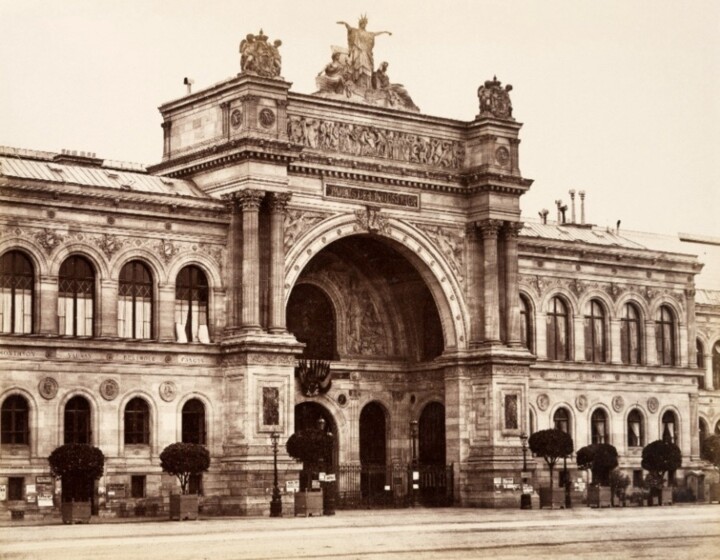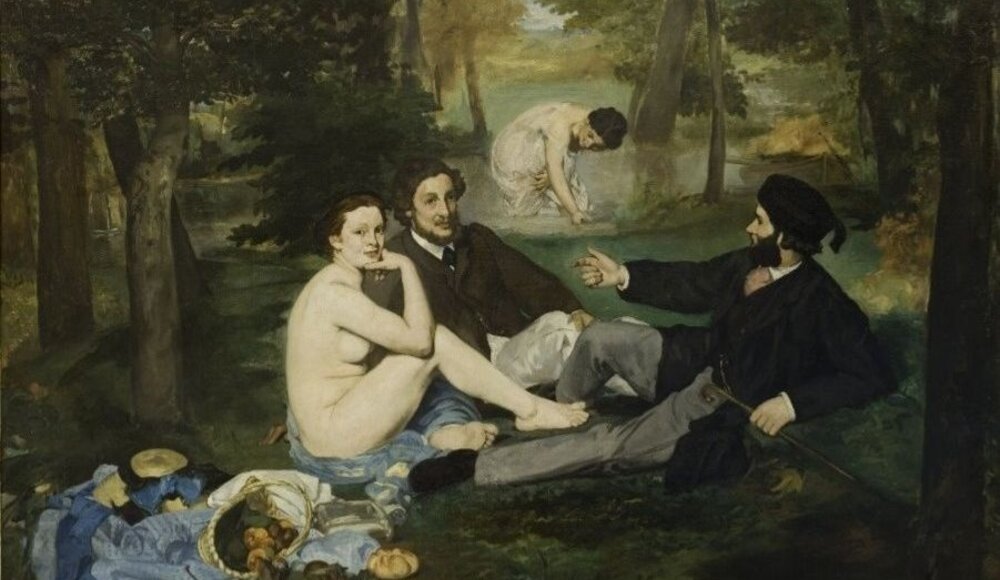 Édouard Manet - Luncheon on the Grass, 1863. Oil on canvas. 208 x 264.5 cm. Musée d'Orsay
Édouard Manet - Luncheon on the Grass, 1863. Oil on canvas. 208 x 264.5 cm. Musée d'Orsay
Who was Édouard Manet?
Édouard Manet (1832-1883) was a French painter and one of the key figures in the transition from Realism to Impressionism. Born in Paris into a wealthy family, Manet initially pursued a career in law but eventually followed his passion for art. He received formal training under the academic painter Thomas Couture but soon developed his own distinctive style that challenged the established artistic norms of the time.
Manet's art was characterized by his innovative approach to composition, brushwork, and subject matter. He rejected the idealized and polished techniques of academic art, instead opting for loose brushwork and a more direct and realistic representation of his subjects. His subjects ranged from everyday scenes of modern life to portraits, still lifes, and historical themes, all imbued with his unique vision.
 Henri Fantin-Latour - Portrait d'Edouard Manet, 1867. Oil on canvas. Art Institute of Chicago
Henri Fantin-Latour - Portrait d'Edouard Manet, 1867. Oil on canvas. Art Institute of Chicago
Manet's paintings often sparked controversy and scandal due to their unconventional nature. Works such as "Olympia" and "The Luncheon on the Grass" challenged societal expectations, particularly in terms of nudity and the portrayal of women. His refusal to conform to traditional standards earned him both criticism and admiration, establishing him as a central figure in the avant-garde art scene.
While Manet faced initial rejection from the official Salon exhibitions, he became a pivotal figure in the Impressionist movement. He influenced and mentored younger artists such as Claude Monet and Edgar Degas, and his bold and innovative techniques helped pave the way for the development of Impressionism. Manet's contributions to art continue to be celebrated, and his impact on the trajectory of modern art cannot be overstated. He remains an important figure in art history, revered for his artistic vision and his role in challenging the conventions of his time.
“The Luncheon on the Grass” (1863)
The controversial nature of the painting sparked discussions and debates about the boundaries of art and the depiction of nudity. It challenged societal taboos surrounding nudity in art and pushed for a more honest and unidealized representation of the human body. By challenging the status quo, "The Luncheon on the Grass" (French: "Le déjeuner sur l'herbe") played a crucial role in expanding the possibilities for artistic expression.
The painting depicts a scene in which a nude woman is having a picnic with two fully dressed men in a rural setting. The composition and subject matter of the painting were unconventional and provocative for the time, leading to a significant scandal when it was first exhibited at the Salon des Refusés in Paris.
The woman's unabashed nudity and the matter-of-fact way in which the figures are presented challenged the established norms and artistic conventions of the era. The juxtaposition of the nude woman with the clothed men further heightened the controversy surrounding the painting.
Manet's intention with "The Luncheon on the Grass" was to challenge the traditional representations of mythological or historical scenes and bring a contemporary subject matter into the realm of high art. He aimed to depict modern life and human relationships in an honest and unidealized manner.
The painting forced viewers to confront their own preconceived notions of art and beauty. It disrupted the conventional ways of looking at and interpreting artworks, encouraging a more critical and subjective engagement with art. "The Luncheon on the Grass" challenged the idea that art should only depict lofty or heroic subjects, opening the door for representations of everyday life and ordinary people.
Manet's unconventional painting technique, characterized by loose brushwork and bold color palette, diverged from the prevailing academic standards of the era. This distinctive approach, later associated with the Impressionist movement, prioritized the depiction of light and color effects over meticulous detail.
The artwork marked a significant turning point in art history, serving as a catalyst for inspiration and influence among later generations of artists. By breaking away from conventional artistic conventions, the painting laid the groundwork for the rise of Impressionism and other modern art movements. Its daring brushwork, unconstrained composition, and unconventional subject matter unlocked possibilities for artists to venture into uncharted artistic territories, challenging established norms and ushering in a revolutionary transformation within the art world.
The painting has become a symbol of artistic innovation and rebellion against established norms. Its controversial reception and subsequent recognition as a groundbreaking work have solidified its place in art history. "The Luncheon on the Grass" is often referenced and studied in discussions about the evolution of art and the breaking of artistic boundaries.
"The Luncheon on the Grass" is currently housed in the Musée d'Orsay in Paris, where it continues to attract visitors from around the world. Its presence in a prestigious art institution highlights its significance and ensures its preservation for future generations to appreciate and study.
Overall, "The Luncheon on the Grass" remains an iconic and influential artwork that challenged the norms of its time, paved the way for artistic experimentation, and continues to inspire artists and viewers alike with its boldness and innovation.
Inspiration
Édouard Manet found inspiration for his painting "The Luncheon on the Grass" from a variety of sources, including art history and contemporary influences. The composition of the painting was influenced by Renaissance artworks like Titian's "Pastoral Concert" and Giorgione's "The Tempest," which featured nude figures in natural settings. Manet reinterpreted this concept in a contemporary context, deviating from idealized and mythological scenes.
 Titian - The Pastoral Concert, 1509. Oil on canvas, 105 x 136.5 cm. Louvre, Paris
Titian - The Pastoral Concert, 1509. Oil on canvas, 105 x 136.5 cm. Louvre, Paris
Additionally, Manet was inspired by Japanese woodblock prints, known as ukiyo-e, which influenced the stylized and graphic elements of his painting. He admired the flattened perspectives, strong outlines, and decorative patterns found in these prints. This aesthetic can be observed in the bold outlines delineating the figures in "The Luncheon on the Grass."
Moreover, Manet was driven by a desire to depict the realities of modern life, departing from the prevalent focus on idealized and historical subjects. Influenced by the Realist movement, he sought to portray everyday scenes and ordinary people in an honest and unromanticized manner. "The Luncheon on the Grass" reflects this aspiration to capture contemporary life and relationships authentically.
Lastly, the controversial Salon exhibitions, organized by the French Academy, played a role in shaping Manet's approach. Frustrated by the rejection of his works by the Salon jury, he seized the opportunity to exhibit his paintings at the Salon des Refusés, which displayed rejected artworks. This context of artistic rebellion and the rejection of traditional norms provided the environment for Manet to challenge conventions and push boundaries with "The Luncheon on the Grass."
 Palais de l'Industrie - Édouard Baldus, 1850s –60s. Albumen silver print. The Metropolitan Museum of Art
Palais de l'Industrie - Édouard Baldus, 1850s –60s. Albumen silver print. The Metropolitan Museum of Art
In summary, Manet drew inspiration from Renaissance art, Japanese prints, the Realist movement, and the Salon exhibitions to create a painting that defied expectations and paved the way for new artistic possibilities. "The Luncheon on the Grass" remains a testament to Manet's innovative vision and his influence on the trajectory of modern art.
Why was “The Luncheon on the Grass” controversial?
"The Luncheon on the Grass" by Édouard Manet was controversial for several reasons:
Nudity: The painting depicted a nude woman, which was considered scandalous and inappropriate for the time. Nudity in art was typically reserved for mythological or historical subjects, but Manet presented a contemporary, everyday scene with a naked woman.
Realism: Manet's realistic portrayal of the figures challenged the idealized and polished representations prevalent in academic art. The woman's unabashed nudity and the casualness of the men's clothing undermined the traditional notions of beauty and propriety.
Composition: The unconventional composition of the painting further fueled controversy. The figures were placed in a seemingly random arrangement, with the nude woman sitting next to the clothed men. This juxtaposition was considered shocking and violated the established rules of composition.
Ambiguity: The narrative and meaning of the painting were ambiguous, leaving room for interpretation. The relationship between the figures was unclear, which added to the scandal. The woman's direct gaze at the viewer challenged societal norms and conventions.
Exhibition at the Salon des Refusés: "The Luncheon on the Grass" was initially rejected by the official Salon exhibition in Paris and instead displayed at the Salon des Refusés (Exhibition of Rejects). The Salon des Refusés showcased artworks rejected by the conservative jury of the official Salon, which already created controversy and public interest around the painting.
These factors combined to create a significant scandal when "The Luncheon on the Grass" was first exhibited. The painting challenged the prevailing artistic and societal norms of the time, paving the way for the emergence of new artistic movements and pushing the boundaries of what was considered acceptable in art.


 Selena Mattei
Selena Mattei